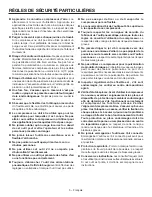
11 – English
Attach hose with quick connect air fitting to 1/4 in. quick
coupler on air compressor. Make sure to push the hose
adapter end fully into the coupler until the sleeve springs
forward to lock it in place.
To disconnect an air hose or an air tool:
Make sure the air compressor is off and confirm that the
outlet pressure is at zero (0) psi.
When disconnecting a hose from 1/4-in. quick coupler,
always firmly hold release end of hose.
Pull back on the release sleeve on the 1/4-in. quick
coupler.
With a firm grip, pull out the quick-connect air fitting that
is attached to the quick coupler.
BREAK-IN PERIOD
Before first use, run the air compressor at zero tank pressure
with the drain valves fully open for 30 minutes.
CAUTION:
On a level surface with the engine off, check the
pump and engine oil levels before each use of the
compressor.
S TA RT I N G A N D S T O P P I N G T H E A I R
COMPRESSOR
See Figures 11 - 14, pages 20 and 21
Before starting the engine:
Connect all hoses.
Check all fluids (oil and gas).
To start the engine:
Turn the fuel valve to the ON position.
Move the choke lever to the START position.
NOTE:
If the engine is warm, leave the choke lever in the
RUN position.
Put the on/stop switch in the ON position.
Grasp the recoil starter and pull slowly until resistance is
felt. Give the recoil starter a short, brisk pull to start the
engine (no more than 4 pulls).
NOTE:
Do not allow the recoil starter to snap back after
starting; return it gently to its original place.
NOTE:
If the engine fails to start, wait several minutes
then repeat the above steps as needed.
Allow the engine to run for 30 seconds, then move the
choke lever to the RUN position.
NOTE:
Once the air compressor is started, pressure
inside the air tank will build until the compressor reaches
145 psi. After reaching maximum tank pressure the
engine will idle allowing the pressure inside the air tank to
decrease until it reaches a preset level. When the pressure
falls below the preset level, the engine will accelerate and
provide additional air pressure.
OPERATION
To stop the engine:
Put the on/stop switch in the OFF position.
WARNING:
The pump exhaust tube will become hot during
use. Avoid contact with the pump exhaust tube
when stopping the engine.
Turn the fuel valve to the OFF position.
WARNING:
Never exceed the air tool’s pressure rating as
recommended by the manufacturer. When using
this air compressor as an inflation device, always
follow the maximum inflation guidelines stated by
the manufacturer of the item being inflated.
WARNING:
Always ensure the on/stop switch is in the
OFF (O)
position and the outlet pressure gauge reads zero
before changing air tools or disconnecting the hose
from the air outlet. Failure to do so could result in
possible serious personal injury.
USING THE AIR COMPRESSOR
See Figures 15 - 16, page 21.
Check all fluids (oil and gas).
Turn off the air compressor.
If not already installed, attach hose to compressor as
previously instructed.
Attach 1/4 in. NPT quick-connect air fitting to accessory
or tool you intend to use.
Insert the other end of the quick-connect air fitting to the
quick coupler on the open end of hose.
Start the air compressor.
Pull out and rotate pressure regulator knob to desired
line pressure. Turning the knob clockwise increases air
pressure at the outlet; turning counterclockwise reduces
air pressure at the outlet.
Following all safety precautions in this manual and the
manufacturer’s instructions in the air tool manual, you
may now proceed to use your air-powered tool.
WARNING:
Air powered tools may require more air consumption
than this air compressor is capable of providing.
Check the tool manual to avoid damage to the tool
or risk of personal injury.












































